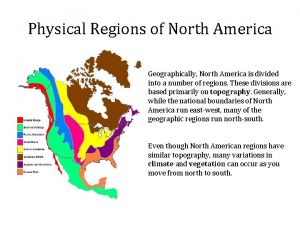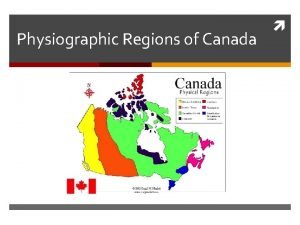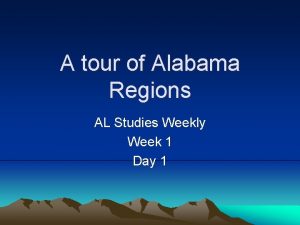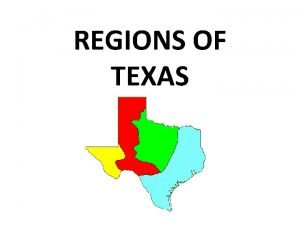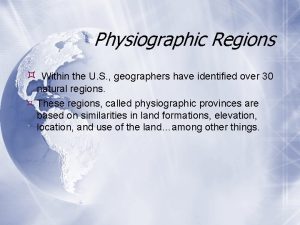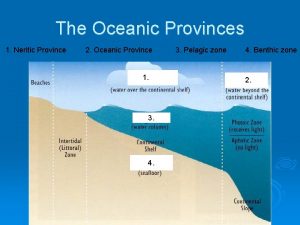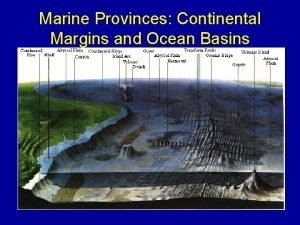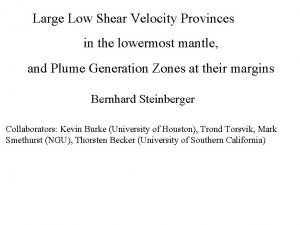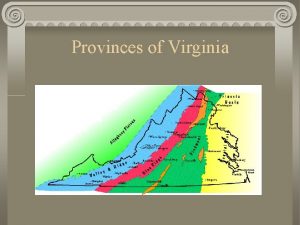Virginia Physical Geography The Physiographic Provinces of Virginia














- Slides: 14

Virginia Physical Geography

The Physiographic Provinces of Virginia �Virginia has had a long, complex geologic history, over 1. 1 billion years �Events that have led to the formation of a rich diversity of rocks, and events that have folded, faulted and rearranged those rocks in complex patterns. �A physiographic province is a landform region, areas divided according to similar terrain that has been shaped by a common geologic history. �Geographers recognize more than 20 physiographic provinces in North America; five of these are in the state of Virginia.

The Physiographic Provinces of Virginia �Each province is characterized overall by its elevation, relief, lithology, and geologic structure. Because of the region’s history of rock formation, deformation, and erosion, specific types of landforms or other geologic features may be associated with a given province.

The Physiographic Provinces of Virginia

Coastal Plain �The Coastal Plain is a flat area underlain by young, unconsolidated sediments. �Includes all of Virginia East of the Fall Line. �The Fall Line is where Rivers cross from the hard igneous and metamorphic rocks of the Piedmont onto the soft roundest rocks in Virginia. � Deposits of sand, silt and clay including marine fossils deposited by rivers. �Layers of sediment were produced by erosion of the Appalachian Mountains and then deposited on the Coastal Plain.

Coastal Plain

Piedmont � The Piedmont is an area of rolling hills underlain by mostly ancient igneous and metamorphic rocks. � Igneous rocks are the roots of volcanoes formed during an ancient episode of subduction that occurred before the formation of the Appalachian Mountains. � Largest physiographic province. � Bounded on the east by the Fall Zone, and on the west by the mountains of the Blue Ridge. � Rolling topography, deeply weathered bedrock and rocks are strongly weathered. � Rocks are generally buried under a thick (2 -20 m) blanket of saprolite. � Topography is more rugged closer to the Blue Ridge.

Piedmont

Blue Ridge �The Blue Ridge is a high ridge of crystalline rock separating the Piedmont from the Valley and Ridge Province. �The billion-year old igneous and metamorphic rocks of the Blue Ridge are the oldest in the state. �The Blue Ridge province experienced mountain building during the Paleozoic era (750 -700 Ma). � In central and northern Virginia, the 570 million year old basalts are over sedimentary rock. �Some metamorphism of these rocks occurred during the formation of the Appalachian Mountains.

Blue Ridge

Valley and Ridge � Long parallel ridges and valleys of sedimentary rock which were folded and faulted, and eroded differently. � 540 million years old sandstones are overlain by carbonates that make up a region of limestone and dolomite. � The folding and faulting of the sedimentary rocks occurred during a collision between Africa and North America. � The collision, which occurred in the late Paleozoic, produced the Appalachian Mountains. � Carbonates were deposited in a shallow tropical ocean along the southeast edge of North America. � Carbonates in the Shenandoah Valley create the correct environment for caves and sinkholes (Karst Topography)

Valley and Ridge

Appalachian Plateau �The Appalachian Plateau has rugged irregular topography and is underlain by ancient, flat-lying sedimentary rocks. �Large folds of rock found in the Valley and Ridge become smaller folds and flatlying rocks in the Plateau. �Some parts of the Plateau are relatively flat, and some are hilly and rugged. �The area is actually a series of plateaus separated by faults. The upper layers of the Plateau are rich in mineral resources like coal, natural gas, and petroleum.

Appalachian Plateau
 Virginia provinces
Virginia provinces China landforms map
China landforms map North china plain map
North china plain map Physiographic divisions of india
Physiographic divisions of india 8 physical regions of north america
8 physical regions of north america Land regions of alabama
Land regions of alabama Physiographic regions of canada
Physiographic regions of canada Alabama studies weekly
Alabama studies weekly Texas state regions
Texas state regions Georgia physiographic regions
Georgia physiographic regions Physiographic regions of russia
Physiographic regions of russia Pelagic province
Pelagic province North canada provinces
North canada provinces Passive and active continental margins
Passive and active continental margins Large low shear velocity provinces
Large low shear velocity provinces




